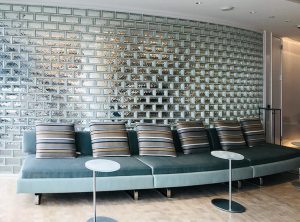The Art and Function of Grout Joints: How Profiles Define the Look and Performance of Thin Brick
Grout joints do far more than fill space between thin bricks—they shape how a wall or floor looks, how it handles light and shadow, and how it stands up to moisture and wear. Because thin brick is so versatile, the joint profile you choose becomes the decisive move, clarifying both the visual language and the long-term performance of the installation. Some joints are all about weathering and durability, others about crisp pattern and depth, and a few exist primarily to deliver a specific aesthetic. The right choice depends on location, exposure, foot traffic, and the character you want the surface to project.
Among the most dependable options, the concave joint is the workhorse. Tooled with a rounded jointer at just the right moment—when the mortar is firm but not fully set—it compresses the mortar into a shallow curve that sheds water and locks the edges tight. The result is a slightly recessed, smooth line that protects against chipping on floors, resists grime buildup, and performs reliably on exterior walls through rain and freeze-thaw cycles. Its strength comes from precision: press too early and the joint tears; too late and the surface crazes. Done properly, it is rugged, clean, and quietly refined.
If you want sharper definition, the V-joint carves a narrow, angled recess that heightens contrast and makes every brick read with intent. The tool’s point splits the joint evenly, densifying both sides so the surface seals against water almost as effectively as a concave profile. On smooth-faced thin brick, strong lighting exaggerates the bevel and turns the wall into a rhythm of crisp lines. Execution matters here: the angle must be consistent in depth and pressure course after course, or the geometry falters and the seal suffers.
At the opposite end of the spectrum, the flush joint aims to disappear. The mortar is struck level with the brick face so the wall reads as a single plane. With no recess to cast shadow, the brick itself carries the texture and color while mops glide across floors without catching and dust has nowhere to settle. Because the edge isn’t compressed into a contour, flush joints are best reserved for interiors or protected exteriors; in wet conditions they do not repel water like curved or beveled profiles.
For dramatic shadow lines, the raked joint pulls the mortar back from the face after initial set, exposing the arris of each brick and carving deeper channels that darken under daylight. This profile is superb for feature walls and façades where you want bolder articulation and less emphasis on mortar color. The tradeoff is weathering: recessed, flat-bottom grooves hold moisture longer, making them vulnerable outdoors, especially in freeze-thaw climates. Indoors, where water is not a threat, the look can be striking and durable.
A weathered joint introduces a functional slope. The upper edge is recessed and the lower edge remains flush, creating a subtle plane that directs water away from the wall. The effect is gentle—more structure than spectacle—adding a soft shadow under each course without deep grooves. It’s a practical choice for covered exteriors and interiors that want depth without the maintenance risks of a raked cut. The angle must always fall from top to bottom; reverse it and you’ve created a shelf.
That reversed slope is the struck joint, which recesses the bottom edge and leaves a small ledge beneath every brick. The visual is crisp in dry, controlled settings, but outdoors the shelf invites standing water, accelerates deterioration, and shortens the life of the work. Designers still use it for interior features or deeply sheltered areas, but its performance window is narrow and the risks are real once weather enters the equation.
For ornamental detail, the beaded joint pushes mortar outward into a raised, rounded ridge centered on the joint. Light skims the bead and throws delicate shadows, shifting attention from the brick to the craft of the line. Because the ridge projects, it is vulnerable to impact and water and therefore better suited to interiors, hallways, and fireplaces than to exposed façades. Consistency is everything: if the bead wobbles or sinks as it cures, the elegance evaporates.
When the goal is age and texture rather than crisp pattern, overgrout—often called a German smear—lets mortar trespass onto the face of the brick, softening edges and blending units into an intentionally weathered surface. The trowel becomes a painter’s tool, deciding how much brick to reveal and how rough the transitions should feel. The look can transform new thin brick into something with old-world heft, but it belongs on walls, not floors; raised mortar will abrade quickly under foot traffic and collect dust in uneven pockets.
Underlying every profile is the material that makes it possible. In brickwork, grout is the binding medium that fills the joints, ties units together, distributes load, and creates the finished surface. With thin brick—where the brick contributes less mass and depth—the joint has to do even more: close the edges against moisture, hold the layout in register, and carry the visual intent. Joint shape, tooling method, and depth determine how light behaves, how dirt accumulates, and how water moves. Sharp lines elevate pattern. Curves soften it. Flat finishes erase it.
No single joint is right for every situation. Concave profiles thrive where durability and water management are critical. V-cuts sharpen modern grids and emphasize alignment. Flush finishes streamline floors and quiet interior walls. Raked recesses pull a surface into graphic relief but ask for dry conditions. Weathered slopes introduce drainage without drama, while struck joints court trouble outside. Beads celebrate ornament and craft, and overgrout rewrites the surface into a continuous, timeworn field. Choose by function first—exposure, traffic, and maintenance—then by the story you want the wall to tell. In brickwork, the joint is not background; it is structure, surface, and rhythm in a single, deliberate line.

